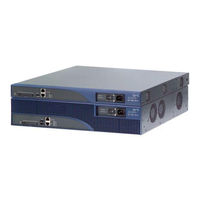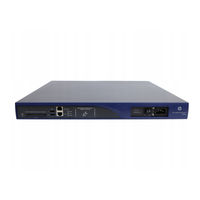3Com MSR 30-16 Manuals
Manuals and User Guides for 3Com MSR 30-16. We have 3 3Com MSR 30-16 manuals available for free PDF download: Configuration Manual, Release Note, Safety Information Manual
3Com MSR 30-16 Configuration Manual (2443 pages)
3Com MSR 30-16: Software Guide
Brand: 3Com
|
Category: Network Router
|
Size: 45.02 MB
Table of Contents
-
-
Overview72
-
Overview76
-
Overview77
-
Overview80
-
Overview83
-
Pos83
-
Sonet/Sdh83
-
Overview99
-
AUX Interface101
-
Overview101
-
USB Interface101
-
Overview102
-
AM Interface103
-
Overview103
-
Overview104
-
Overview106
-
Overview110
-
E1-F Interface115
-
Overview115
-
Overview117
-
T1-F Interface117
-
CE3 Interface119
-
Overview119
-
CT3 Interface122
-
Overview122
-
ATM Overview127
-
Ipoa129
-
Ipoeoa129
-
Pppoa129
-
Pppoeoa129
-
Configuring ATM130
-
Configuring Ipoa136
-
Ping Failure149
-
Overview153
-
DCC Features156
-
-
Task158
-
Troubleshooting208
-
Dlsw Overview211
-
Introduction211
-
Configuring Dlsw218
-
-
Overview235
-
Virtual Circuit235
-
Overview253
-
Overview257
-
Overview263
-
Ppp Ofr263
-
Mp Ofr265
-
Overview265
-
Garp271
-
Gvrp274
-
Configuring GVRP275
-
HDLC Overview281
-
Configuring HDLC282
-
Configuring LAPB285
-
Configuring X.25286
-
Configuring X2T312
-
Introduction312
-
Lacp345
-
Link Aggregation345
-
Troubleshooting357
-
Ppp363
-
Configuring PPP367
-
Configuring MP374
-
Configuring IPHC378
-
Bridge Routing420
-
Configuring ISDN422
-
Incoming Call429
-
Troubleshooting441
-
MSTP Overview443
-
Prerequisites478
-
VLAN Overview487
-
VLAN Fundamental488
-
Concept511
-
Dynamic511
-
Features511
-
Overview511
-
Implementation512
-
Example I513
-
Example II516
-
Example III518
-
-
Dialer Interface525
-
Null Interface526
-
Sub-Interface527
-
Configuring VT534
-
Configuring VE536
-
Troubleshooting536
-
Cpos539
-
Overview539
-
Sonet/Sdh539
-
-
Terms540
-
-
Overhead Byte542
-
ARP Function549
-
ARP Overview549
-
ARP Process550
-
Configuring ARP552
-
Interface552
-
DHCP Options568
-
Enabling DHCP575
-
-
Fundamentals589
-
-
-
Enabling DHCP591
-
-
DNS Overview609
-
DNS Proxy611
-
IP Unnumbered625
-
Basic Concepts651
-
Processing Flow651
-
URPF Overview651
-
Configuring URPF652
-
Ipv6 Features655
-
Ipv6 Overview655
-
NAT-PT Overview679
-
NAT-PT Mechanism680
-
Enabling NAT-PT682
-
PE Overview699
-
Routing815
-
Route Recursion819
-
BGP Overview825
-
Mp-Bgp839
-
-
Prerequisites846
-
-
-
Prerequisites849
-
-
IS-IS Overview877
-
Basic Concepts877
-
-
IS-IS Area879
-
IS-IS PDU Format883
-
-
Basic Concepts918
-
-
Related Rfcs937
-
-
-
Prerequisites940
-
-
-
Prerequisites941
-
-
-
Prerequisites942
-
-
-
Prerequisites946
-
-
RIP Overview971
-
Operation of RIP972
-
RIP Version973
-
Trip975
Advertisement
3Com MSR 30-16 Release Note (17 pages)
MSR Family Software Version 5.20
Brand: 3Com
|
Category: Network Router
|
Size: 0.09 MB
Table of Contents
-
-
BOOT Menu10
3Com MSR 30-16 Safety Information Manual (12 pages)
Safety and Compliance Information (v1.01)
Brand: 3Com
|
Category: Network Router
|
Size: 0.39 MB
Table of Contents
Advertisement
Advertisement


